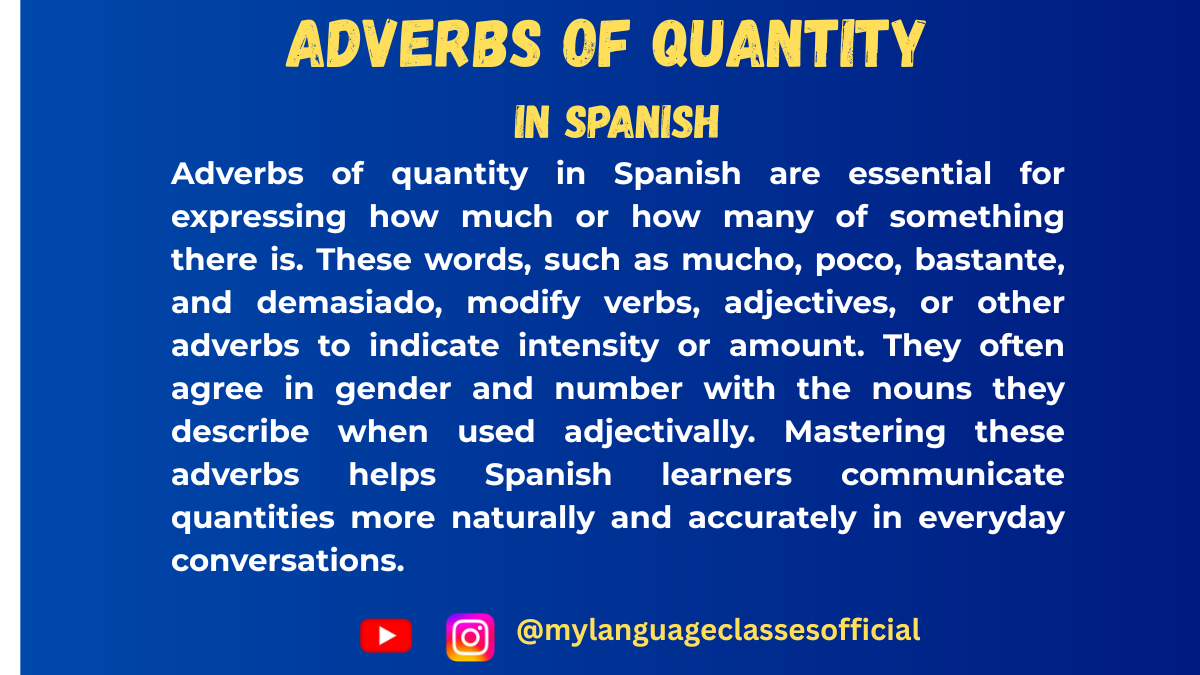Your cart is currently empty!
Tag: language
-
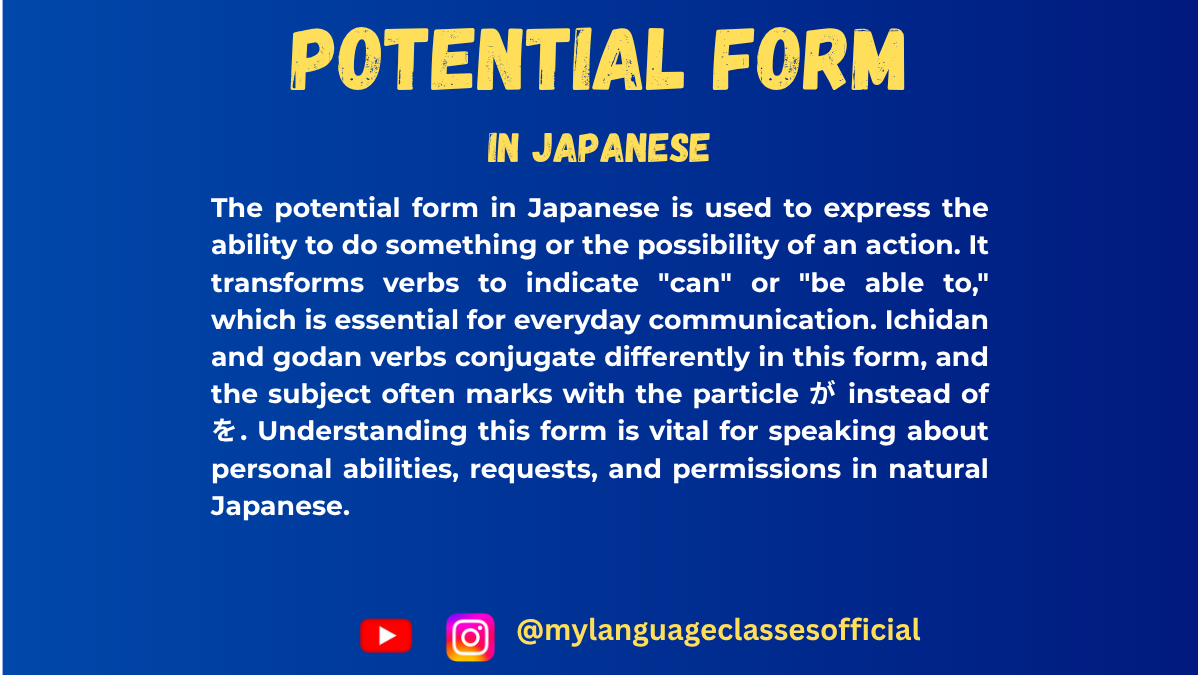
Potential Form of Verbs in Japanese | My Language Classes
Understanding Potential Form
The potential form (可能形, かのうけい) of verbs in Japanese expresses the ability or possibility to do something. This form is widely used in everyday conversations to talk about what someone can or cannot do.
Usage of Potential Form in Different Situations
- Expressing Ability
- 日本語を話せます。(I can speak Japanese.)
- Expressing Capability
- ここから富士山が見えます。(You can see Mount Fuji from here.)
- Expressing Permission
- この図書館では本を借りられます。(You can borrow books in this library.)
- Expressing Physical or Situational Possibility
- 今日は忙しいので、映画に行けません。(I am busy today, so I can’t go to the movies.)
- Expressing Potential in Hypothetical Scenarios
- 彼が来たら、もっと話せると思います。(If he comes, I think I will be able to talk more.)
- Asking About Ability
- ピアノが弾けますか? (Can you play the piano?)
- Denying Capability
- 漢字が読めません。(I can’t read kanji.)
- Expressing Limited Ability (Using なら)
- スペイン語なら話せます。(If it’s Spanish, I can speak it.)
Formation of Potential Form
Japanese verbs are categorized into three groups, and the potential form is formed differently for each.
Group 1 (Godan Verbs / 五段動詞)
For 五段動詞 (Godan verbs), replace the final う sound with える.
Dictionary Form Potential Form Example Sentence 1 Example Sentence 2 書く (to write) 書ける 日本語が書けます。(I can write in Japanese.) 漢字が書けません。(I can’t write kanji.) 行く (to go) 行ける 明日、海に行けます。(I can go to the beach tomorrow.) 東京には行けません。(I can’t go to Tokyo.) 話す (to speak) 話せる 日本語が話せますか?(Can you speak Japanese?) 彼は英語が話せません。(He can’t speak English.) 飲む (to drink) 飲める お酒が飲めますか?(Can you drink alcohol?) ビールが飲めません。(I can’t drink beer.) 泳ぐ (to swim) 泳げる 彼は速く泳げます。(He can swim fast.) 海では泳げません。(I can’t swim in the sea.) 買う (to buy) 買える この店でケーキが買えます。(You can buy cakes at this shop.) 今日は買えません。(I can’t buy it today.) 作る (to make) 作れる 美味しい料理が作れます。(I can make delicious food.) パンは作れません。(I can’t make bread.) Group 2 (Ichidan Verbs / 一段動詞)
For 一段動詞 (Ichidan verbs), replace る with られる.
Dictionary Form Potential Form Example Sentence 1 Example Sentence 2 食べる (to eat) 食べられる 何でも食べられます。(I can eat anything.) 魚が食べられません。(I can’t eat fish.) 見る (to see) 見られる この映画が見られます。(You can watch this movie.) 明日は見られません。(I can’t watch it tomorrow.) 着る (to wear) 着られる 和服が着られます。(I can wear a kimono.) その服は着られません。(I can’t wear those clothes.) 起きる (to wake up) 起きられる 朝6時に起きられます。(I can wake up at 6 AM.) 今日は早く起きられません。(I can’t wake up early today.) 忘れる (to forget) 忘れられる 昨日のことが忘れられます。(I can forget about yesterday.) その話は忘れられません。(I can’t forget that story.) Group 3 (Irregular Verbs / 不規則動詞)
The two irregular verbs in Japanese have unique potential forms.
Dictionary Form Potential Form Example Sentence 1 Example Sentence 2 する (to do) できる サッカーができます。(I can play soccer.) 今日は運動ができません。(I can’t exercise today.) 来る (to come) 来られる 彼は会議に来られます。(He can come to the meeting.) 明日は来られません。(I can’t come tomorrow.) More Example Sentences
- 私は日本語が話せます。
(I can speak Japanese.) → [Godan Verb: 話す → 話せる] - この店ではケーキが買えます。
(You can buy cakes at this shop.) → [Godan Verb: 買う → 買える] - 今日は早く起きられません。
(I can’t wake up early today.) → [Ichidan Verb: 起きる → 起きられる] - この映画はネットで見られます。
(You can watch this movie online.) → [Ichidan Verb: 見る → 見られる] - ピアノが弾けますか?
(Can you play the piano?) → [Godan Verb: 弾く → 弾ける] - 彼は速く泳げます。
(He can swim fast.) → [Godan Verb: 泳ぐ → 泳げる] - 明日は学校に行けません。
(I can’t go to school tomorrow.) → [Godan Verb: 行く → 行ける] - この本は図書館で借りられます。
(You can borrow this book from the library.) → [Ichidan Verb: 借りる → 借りられる] - サッカーができますか?
(Can you play soccer?) → [Irregular Verb: する → できる] - 彼は明日の会議に来られます。
(He can come to tomorrow’s meeting.) → [Irregular Verb: 来る → 来られる]
These examples cover various real-life situations where the potential form is commonly used. Let me know in comment if you need more examples!
Fill in the Blanks Exercise:
- 日本語が____ますか? (Can you speak Japanese?)
- この映画はネットで____ます。 (You can watch this movie online.)
- 今日は早く____ません。 (I can’t wake up early today.)
- 美味しい料理が____ますか? (Can you make delicious food?)
- ここでは写真を____ません。 (You can’t take pictures here.)
- 彼女はピアノが____ません。 (She can’t play the piano.)
- この店ではケーキが____ます。 (You can buy cakes at this shop.)
- その本が____ますか? (Can you read that book?)
- 彼は会議に____ますか? (Can he come to the meeting?)
- お酒が____ません。 (I can’t drink alcohol.)
Answers
- 話せ
- 見られ
- 起きられ
- 作れ
- 撮れ
- 弾け
- 買え
- 読め
- 来られ
- 飲め
Notes on Usage
- Shortened Form of Ichidan Verbs: In casual speech, some people drop ら from られる and say 食べれる, 見れる, etc. However, this is considered informal and not grammatically standard.
- Using を or が: When using potential form, the object marker を is often replaced with が.
- Correct: 漢字が書ける。
- Acceptable (less common): 漢字を書ける。
- Negative Form: Add ない to the potential form.
- 漢字が読めない (I can’t read kanji.)
- Polite Form: Add ます to the potential form.
- 漢字が読めます (I can read kanji.)
Mastering the potential form will help you express what you can and cannot do in Japanese fluently! Try using it in daily conversations to reinforce your understanding. 頑張ってください! (Good luck!)
If you enjoyed this lesson, be sure to check out more posts like this on my blog at My Language Classes. Don’t forget to subscribe my YouTube channel and follow me on Instagram for the latest language learning tips and lessons. Leave a comment below to share your thoughts, or ask any questions you have about nouns.
Happy learning! 😊
- Expressing Ability
-
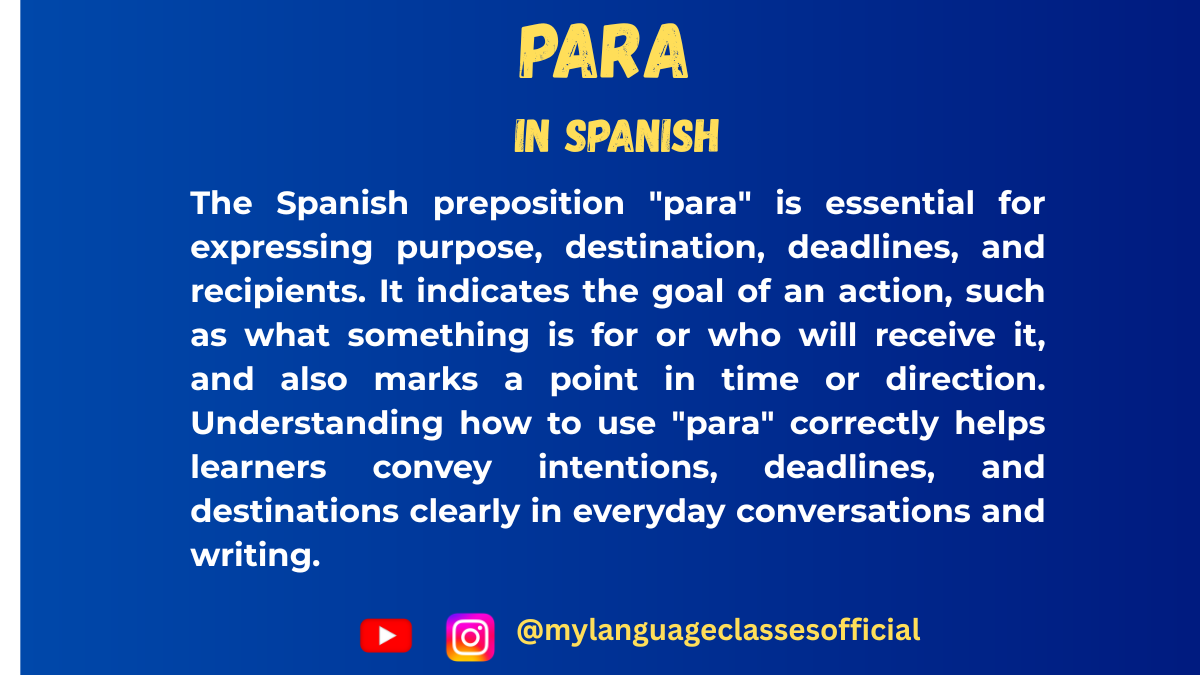
Everything You Need to Know About PARA in Spanish
When learning Spanish, one of the trickiest aspects is understanding the difference between “por” and “para.” While both can translate to “for” in English, they serve different purposes in Spanish. This article will focus on “para”—its uses, common expressions, and grammatical rules.
Uses of PARA in Spanish
“Para” is generally used to indicate purpose, destination, deadlines, recipients, and opinions. Below is a detailed explanation of its main uses:
Usage Explanation Example Sentence Purpose (In order to) Used to indicate the reason for doing something. Often translates to “in order to” in English. Estudio español para hablar con fluidez. (I study Spanish in order to speak fluently.) Recipient (For someone) Used when something is intended for a person or entity. Este regalo es para ti. (This gift is for you.) Destination (Towards a place) Indicates movement towards a destination. Salimos para Madrid mañana. (We are leaving for Madrid tomorrow.) Deadline (By, For a time limit) Used to indicate a deadline for an action. La tarea es para mañana. (The homework is for tomorrow.) Employment (To work for someone) Indicates employment or who you work for. Trabajo para una empresa grande. (I work for a big company.) Comparison (Considering that) Used when making a comparison or contrast. Para un niño de 5 años, él es muy alto. (For a five-year-old, he is very tall.) Opinion (According to someone) Used to express personal opinions. Para mí, este restaurante es el mejor. (For me, this restaurant is the best.) Use (For a specific use) Used when indicating the purpose of an object. Necesito un cepillo para el pelo. (I need a brush for my hair.)
Common Expressions with PARA
Below is a list of commonly used phrases and idioms with para in daily Spanish:
Expression Meaning Example Sentence Estar para + infinitive To be about to do something Estoy para salir. (I am about to leave.) Para siempre Forever Te amaré para siempre. (I will love you forever.) Para nada Not at all No me gusta el café para nada. (I don’t like coffee at all.) Para variar Just for a change Hoy vamos a la playa para variar. (Today we are going to the beach just for a change.) No es para tanto It’s not a big deal No llores, no es para tanto. (Don’t cry, it’s not a big deal.) Para colmo To top it all off Perdimos el tren y, para colmo, empezó a llover. (We missed the train, and to top it all off, it started raining.) Para que (+ subjunctive) So that Estudia mucho para que pases el examen. (Study hard so that you pass the exam.) Ser tal para cual To be two of a kind Juan y Ana son tal para cual. (Juan and Ana are two of a kind.)
Important Grammar Rules When Using PARA
1. Articles with PARA
- When using para before a noun, it may require a definite or indefinite article (el, la, los, las, un, una, unos, unas).
- Example: Este libro es para el profesor. (This book is for the teacher.)
2. Singular vs. Plural Forms
- “Para” itself does not change with gender or number, but the words following it do.
- Example: Las flores son para las madres. (The flowers are for the mothers.)
3. Using PARA with Pronouns
- Personal pronouns with “para”: para mí, para ti, para él/ella, para nosotros, para ellos.
- Example: Este mensaje es para ti. (This message is for you.)
4. PARA vs. POR
Since “por” and “para” both mean “for” in English, beginners often confuse them. Here’s a simple trick:
- Use PARA when there’s a destination or purpose. (Voy para Madrid.)
- Use POR when there’s a cause or reason. (Voy por el trabajo.)
Things to Keep in Mind When Using PARA
- If you are expressing a purpose (“in order to”), always use the infinitive verb form after “para.”
✅ Vine para aprender español. (I came to learn Spanish.)
❌ Vine para aprendo español. (Incorrect) - “Para” is not used when talking about duration—use “por” instead.
✅ Estudié por dos horas. (I studied for two hours.)
❌ Estudié para dos horas. (Incorrect) - In spoken Spanish, native speakers often use “para” with shortened forms like “pa’” in informal speech.
Example: Voy pa’ la casa. (I’m going home.) (Casual speech)
Final Thoughts
Understanding para is crucial for mastering Spanish. By learning its different uses and practicing with common expressions, you’ll improve both comprehension and fluency. Try to use para in your daily conversations, and pay attention to how native speakers use it!
If you enjoyed this lesson, be sure to check out more posts like this on my blog at My Language Classes. Don’t forget to subscribe my YouTube channel and follow me on Instagram for the latest language learning tips and lessons. Leave a comment below to share your thoughts, or ask any questions you have.
Happy learning! 😊
-

Everything You Need to Know About POR in Spanish
One of the most challenging aspects of learning Spanish is understanding the difference between por and para. Both words can be translated as “for,” but they are used in different contexts. In this blog post, we will focus entirely on por, explaining its various uses, common expressions, grammatical considerations, and examples to help you master it like a native speaker.
Main Uses of POR in Spanish
The preposition por is used in multiple contexts in Spanish. Below is a breakdown of its main uses along with example sentences.
Usage Explanation Example Sentence Cause or Reason Used to explain the reason behind an action (similar to “because of”). Me castigaron por llegar tarde. (They punished me for arriving late.) Duration of Time Used to express how long something lasts. Estudié español por tres años. (I studied Spanish for three years.) Exchange or Substitution Used when something is exchanged or substituted. Te doy mi libro por tu cuaderno. (I’ll give you my book for your notebook.) Means of Communication or Transportation Used to indicate how something is done. Hablamos por teléfono. (We spoke on the phone.) / Viajé por tren. (I traveled by train.) Movement Through a Place Used when referring to motion through or around a place. Caminamos por el parque. (We walked through the park.) General Location Used to indicate an approximate location. Vive por aquí. (He/She lives around here.) Agent in Passive Voice Used to indicate who performed an action in the passive voice. El libro fue escrito por Gabriel García Márquez. (The book was written by Gabriel García Márquez.) Multiplication or Measurement Used in mathematics or measurements. Cinco por cinco es veinticinco. (Five times five is twenty-five.) Motive or Reason for an Action (on behalf of someone) Used when doing something for someone else. Lo hice por ti. (I did it for you.) Gratitude or Apology Used to express thanks or apologies. Gracias por tu ayuda. (Thanks for your help.) Emotion Towards Someone or Something Used to express feelings. Tengo mucho respeto por mis profesores. (I have a lot of respect for my teachers.)
Common Expressions with POR
Many fixed expressions in Spanish include por. Here is a list of some of the most common ones, their meanings, and example sentences.
Expression Meaning Example Sentence Por favor Please Por favor, dime la verdad. (Please, tell me the truth.) Por supuesto Of course Por supuesto que te ayudaré. (Of course, I will help you.) Por fin Finally Por fin llegaron las vacaciones. (Finally, the holidays arrived.) Por lo menos At least Necesito dormir por lo menos ocho horas. (I need to sleep at least eight hours.) Por ejemplo For example Me gustan los deportes, por ejemplo, el fútbol. (I like sports, for example, soccer.) Por ahora For now No tengo trabajo, por ahora. (I don’t have a job, for now.) Por si acaso Just in case Lleva un paraguas, por si acaso llueve. (Take an umbrella, just in case it rains.) Por desgracia Unfortunately Por desgracia, no puedo ir a la fiesta. (Unfortunately, I can’t go to the party.) Por todos lados Everywhere Hay turistas por todos lados. (There are tourists everywhere.) Por eso That’s why Está lloviendo, por eso llevamos paraguas. (It’s raining, that’s why we’re carrying umbrellas.) Por mi parte As for me Por mi parte, prefiero quedarme en casa. (As for me, I prefer to stay home.)
Things to Keep in Mind When Using POR
1. Gender and Number Agreement
- Por itself does not change for gender or number, but the articles and adjectives surrounding it must agree with the noun.
- Example: Caminamos por el bosque. (We walked through the forest.)
- Example: Pasamos por la plaza. (We passed through the square.)
2. When Not to Use POR
- Many learners confuse por and para. If you are referring to a destination, purpose, or deadline, use para instead of por.
- Correct: Este regalo es para ti. (This gift is for you.)
- Incorrect: Este regalo es por ti.
3. Using POR in Questions
- Por qué = Why? (Used in questions.)
- Example: ¿Por qué estudias español? (Why do you study Spanish?)
- Porque = Because (Used in answers.)
- Example: Estudio español porque me gusta. (I study Spanish because I like it.)
Conclusion
Mastering por is essential for fluency in Spanish. It appears in many everyday expressions, grammatical structures, and idiomatic phrases. By understanding its various meanings and practicing its usage, you will be able to speak Spanish more naturally. Keep an eye on key differences between por and para, and remember the most common expressions with por to improve your conversational skills!
If you enjoyed this lesson, be sure to check out more posts like this on my blog at My Language Classes. Don’t forget to subscribe my YouTube channel and follow me on Instagram for the latest language learning tips and lessons. Leave a comment below to share your thoughts, or ask any questions you have.
Happy learning! 😊
- Por itself does not change for gender or number, but the articles and adjectives surrounding it must agree with the noun.
-
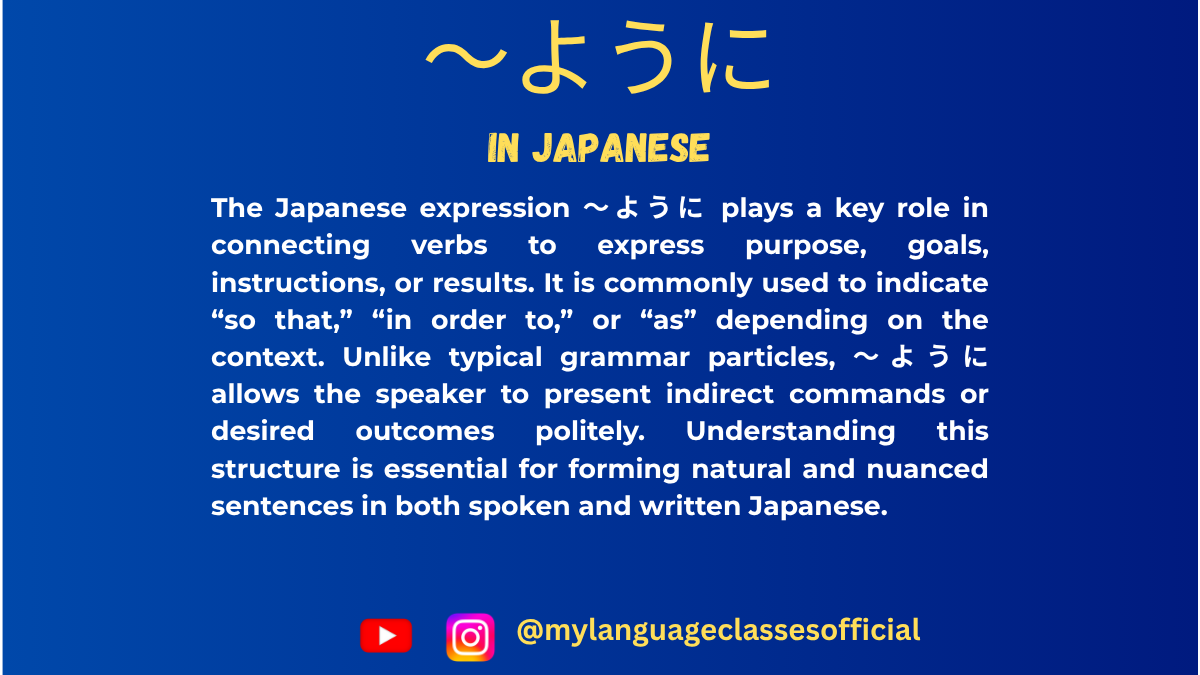
Understanding 〜ように in Japanese | My Language Classes
Using 〜ように in Japanese
The Japanese expression 「〜ように」 is an essential grammatical structure that serves various purposes, including expressing hopes, requests, instructions, comparisons, goals, and habitual actions. This guide will provide an in-depth look at the different uses of 「〜ように」, along with clear explanations and example sentences.
1. Expressing Hopes or Wishes
「〜ように」 is used to express a hope or wish for something to happen, similar to saying “I hope that…” in English.
Structure:
Verb (potential form / negative form) + ように
Examples:
- 試験に合格できますように。
(Shiken ni goukaku dekimasu you ni.)
→ “I hope I can pass the exam.” - 雨が降らないように。
(Ame ga furanai you ni.)
→ “I hope it doesn’t rain.”
2. Expressing Goals or Objectives
This usage is similar to saying “in order to” in English. It indicates a goal or purpose for an action.
Structure:
Verb (potential form / dictionary form) + ように
Examples:
- 日本語が話せるように、毎日勉強しています。
(Nihongo ga hanaseru you ni, mainichi benkyou shiteimasu.)
→ “I study every day in order to be able to speak Japanese.” - 風邪を引かないように、マフラーをします。
(Kaze wo hikanai you ni, mafuraa wo shimasu.)
→ “I wear a scarf so that I don’t catch a cold.”
3. Giving Instructions or Advice (Indirect Commands)
When making polite or indirect requests, suggestions, or advice, 「〜ように」 is often used.
Structure:
Verb (plain non-past form) + ように 言う / 注意する / 頼む / 伝える
Examples:
- 先生は学生に宿題を忘れないように言いました。
(Sensei wa gakusei ni shukudai wo wasurenai you ni iimashita.)
→ “The teacher told the students not to forget their homework.” - 医者に早く寝るように注意された。
(Isha ni hayaku neru you ni chuui sareta.)
→ “The doctor advised me to sleep early.” - 彼に遅刻しないように頼みました。
(Kare ni chikoku shinai you ni tanomimashita.)
→ “I asked him not to be late.”
4. Making Comparisons
When used with verbs like なる (to become), 「〜ように」 can indicate a comparison or similarity.
Structure:
Noun + のように / Verb (plain form) + ように
Examples:
- 彼は先生のように話します。
(Kare wa sensei no you ni hanashimasu.)
→ “He speaks like a teacher.” - この部屋はまるでホテルのように綺麗です。
(Kono heya wa marude hoteru no you ni kirei desu.)
→ “This room is as clean as a hotel.”
5. Indicating Habitual Actions or Natural Consequences
This structure shows that something naturally happens or occurs habitually.
Structure:
Verb (dictionary form / negative form) + ようになる
Examples:
- 毎日練習して、日本語が話せるようになった。
(Mainichi renshuu shite, nihongo ga hanaseru you ni natta.)
→ “After practicing every day, I became able to speak Japanese.” - 最近、早く起きるようになりました。
(Saikin, hayaku okiru you ni narimashita.)
→ “Recently, I have started waking up early.”
6. Expressing Something Indirectly
When introducing a previous statement or explanation, 「〜ように」 can mean “as mentioned before” or “as expected.”
Structure:
Verb (plain form) + ように
Examples:
- 前に話したように、このプロジェクトは重要です。
(Mae ni hanashita you ni, kono purojekuto wa juuyou desu.)
→ “As I mentioned before, this project is important.” - 先生が言ったように、復習することが大切です。
(Sensei ga itta you ni, fukushuu suru koto ga taisetsu desu.)
→ “As the teacher said, reviewing is important.”
7. Expressing a Desired Outcome in a Prayer or Wish
This structure is common in prayers and formal expressions.
Structure:
Verb (potential form / negative form) + ように
Examples:
- みんなが幸せになりますように。
(Minna ga shiawase ni narimasu you ni.)
→ “I hope everyone becomes happy.” - 悪いことが起こらないように。
(Warui koto ga okoranai you ni.)
→ “I hope nothing bad happens.”
Summary: Situations Where 「〜ように」 is Used
Usage Meaning Example Expressing Hopes or Wishes “I hope that…” 試験に合格できますように。 Expressing Goals “In order to…” 日本語が話せるように勉強しています。 Giving Instructions / Advice Indirect commands 先生は学生に宿題を忘れないように言いました。 Making Comparisons “Like…” 彼は先生のように話します。 Indicating Habitual Actions “To become able to…” 日本語が話せるようになった。 Introducing Statements “As mentioned…” 前に話したように、このプロジェクトは重要です。 Expressing Wishes in Prayer Formal wishes みんなが幸せになりますように。
Conclusion
「〜ように」 is a versatile and essential grammar structure in Japanese. Understanding its different uses can greatly enhance your ability to communicate hopes, goals, indirect commands, comparisons, and habitual changes. By mastering this structure, you will sound more natural and fluent in Japanese!
Would you like me to cover any other grammar points in detail? Let me know in the comments!
If you enjoyed this lesson, be sure to check out more posts like this on my blog at My Language Classes. Don’t forget to subscribe my YouTube channel and follow me on Instagram for the latest language learning tips and lessons. Leave a comment below to share your thoughts, or ask any questions you have about nouns.
Happy learning! 😊
- 試験に合格できますように。
-
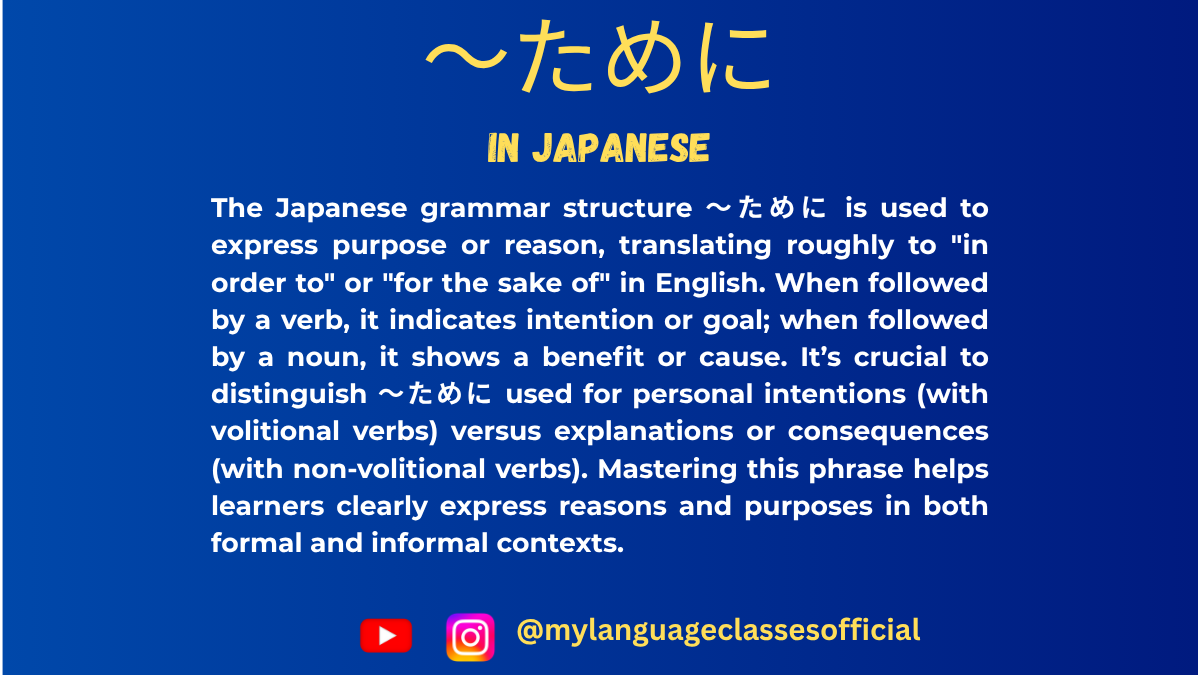
Using 〜ために in Japanese | My Language Classes
Understanding 〜ために in Japanese
In Japanese, “〜ために” (tame ni) is a highly versatile grammatical structure used to indicate purpose, reason, or benefit. Understanding its different meanings and contexts is crucial for mastering the Japanese language.
This article will explain all the possible uses of “ために” along with example sentences and a list of situations where it is commonly used.
**1. Expressing Purpose (目的)
The most common use of “ために” is to express purpose or intention. In this case, it is used with dictionary form verbs or nouns.**
Structure:
- Verb (dictionary form) + ために
- Noun + の + ために
Examples:
- 体重を減らすために歩いています。 (I walk in order to lose weight.)
- 簡単な日本語を勉強するためにこのアプリを使う。 (I use this app to study simple Japanese.)
- 健康のために毎日ヨガをしています。 (For my health, I do yoga every day.)
Note:
- “ために” is used for intentional actions performed by someone with a goal in mind.
2. Expressing Reason or Cause (原因)
“ために” can also be used to express a reason or cause for a particular event, similar to “because of” in English.
Structure:
- Verb (plain past form) + ために
- Noun + の + ために
Examples:
- 天気が悪かったためにゲームが中止された。 (Because of bad weather, the game was canceled.)
- 病気のために休んだ。 (I took a break because of illness.)
- 仕事が大変だったためにとても疲れています。 (Because work was difficult, I am very tired.)
Note:
- In this case, the outcome is not controlled by the speaker and is often negative.
3. Expressing Benefit or Effect (利益)
Another meaning of “ために” is to indicate the benefit or positive effect of something.
Structure:
- Noun + の + ために
Examples:
- 子供のために私たちは最良の教育を提供したい。 (For the benefit of children, we want to provide the best education.)
- 世界のために安全な環境を作りましょう。 (For the benefit of the world, let’s create a safe environment.)
Note:
- This use of “ために” is often found in formal speech, policies, and slogans.
4. “ために” vs. “ように” (Comparison)
Both “ために” and “ように” express purpose, but they have different uses:
Phrase Used with Meaning ために Dictionary-form verbs (intentional) Purpose (the subject can control the action) ように Potential-form verbs or non-intentional actions Purpose (the subject cannot directly control the action) Examples:
- ために: 体重を減らすために歩いています。 (I walk in order to lose weight.)
- ように: 日本語を話せるように勉強している。 (I study so that I can speak Japanese.)
Key difference: “ために” is used when the subject can control the outcome, while “ように” is used for situations where the outcome depends on ability or an external factor.
Situations Where 〜ために is Used
Situation Example Expressing Purpose 旅行するためにお金を貯めています。 Expressing Reason 天気が悪かったためにコンサートが中止された。 Expressing Benefit 社会のために活動しています。
Conclusion
The structure “ために” is an essential part of Japanese grammar, used to express purpose, reason, and benefit. Mastering its different uses will greatly improve your ability to form complex and meaningful sentences in Japanese.
Understanding the differences between “ために” and similar expressions like “ように” will help you sound more natural in Japanese conversations. Keep practicing and using “ために” in different contexts!
If you enjoyed this lesson, be sure to check out more posts like this on my blog at My Language Classes. Don’t forget to subscribe my YouTube channel and follow me on Instagram for the latest language learning tips and lessons. Leave a comment below to share your thoughts, or ask any questions you have about nouns.
Happy learning! 😊
-
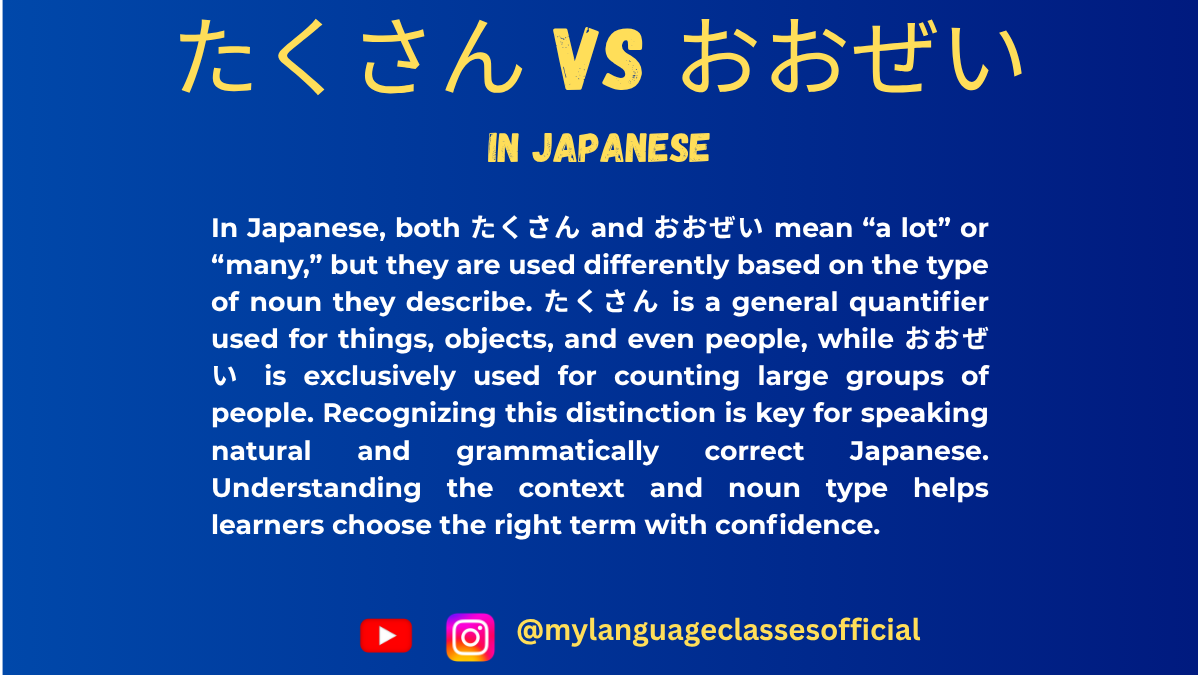
たくさん vs おおぜい: the Differences in Japanese | My Language Classes
たくさん vs おおぜい
When learning Japanese, many students come across the words たくさん (takusan) and おおぜい (oozei), both of which mean “a lot” or “many.” However, they are not interchangeable in every situation. Understanding their nuances will help you use them naturally in conversations and writing.
1. Basic Meaning and Key Difference
- たくさん (takusan): Means “a lot,” “many,” or “plenty” and can be used for both countable and uncountable nouns.
- おおぜい (oozei): Specifically refers to “a large number of people” and is used only for people.
2. Usage of たくさん (takusan)
A. With Countable and Uncountable Nouns
- たくさん can be used with both things that can be counted (books, apples, pens) and things that cannot be counted (water, happiness, love).
Examples:
- 机の上に本がたくさんあります。
Tsukue no ue ni hon ga takusan arimasu.
→ There are many books on the desk. - 今日は仕事がたくさんあります。
Kyou wa shigoto ga takusan arimasu.
→ I have a lot of work today. - 私はお金をたくさん持っています。
Watashi wa okane o takusan motteimasu.
→ I have a lot of money.
B. Placement of たくさん in a Sentence
- Before the noun (less common in daily speech):
- たくさんの友達がいます。(Takusan no tomodachi ga imasu.)
→ I have many friends.
- たくさんの友達がいます。(Takusan no tomodachi ga imasu.)
- After the noun (more natural):
- 友達がたくさんいます。(Tomodachi ga takusan imasu.)
→ I have many friends.
- 友達がたくさんいます。(Tomodachi ga takusan imasu.)
- With verbs (indicating an action done in large amounts):
- ご飯をたくさん食べました。(Gohan o takusan tabemashita.)
→ I ate a lot of food.
- ご飯をたくさん食べました。(Gohan o takusan tabemashita.)
3. Usage of おおぜい (oozei)
A. Used Only for a Large Number of People
- おおぜい is exclusively used when talking about a crowd, a large number of people, or a gathering.
Examples:
- コンサートにはおおぜいの人が来ました。
Konsaato ni wa oozei no hito ga kimashita.
→ A large number of people came to the concert. - その町には観光客がおおぜいいました。
Sono machi ni wa kankoukyaku ga oozei imashita.
→ There were many tourists in that town. - おおぜいの学生が試験を受けました。
Oozei no gakusei ga shiken o ukemashita.
→ A lot of students took the exam.
B. Placement of おおぜい in a Sentence
- Before the noun:
- おおぜいの人が集まりました。(Oozei no hito ga atsumarimashita.)
→ Many people gathered.
- おおぜいの人が集まりました。(Oozei no hito ga atsumarimashita.)
- After the noun (less common but acceptable):
- 人がおおぜい集まりました。(Hito ga oozei atsumarimashita.)
→ A lot of people gathered.
- 人がおおぜい集まりました。(Hito ga oozei atsumarimashita.)
4. Situations Where たくさん and おおぜい Are Used
Situation Use たくさん Use おおぜい Talking about a large number of objects (books, apples, cars, etc.) ✅ Yes ❌ No Talking about a large quantity of uncountable things (water, love, money, etc.) ✅ Yes ❌ No Talking about a large number of people ✅ Yes ✅ Yes Talking about a crowd or a gathering of people ❌ No ✅ Yes Used with verbs like “eat” or “buy” (大量に食べる, 大量に買う) ✅ Yes ❌ No Used before a noun as an adjective ✅ Yes (たくさんの) ✅ Yes (おおぜいの) Used after a noun naturally ✅ Yes ✅ Yes (but limited to people) 5. Summary of Key Differences
Word Meaning Used for Example Sentence たくさん (takusan) A lot, many, plenty Both people and things 友達がたくさんいます。 (I have many friends.) おおぜい (oozei) A large number of people, crowd Only people コンサートにおおぜいの人が来ました。 (A large number of people came to the concert.) 6. Common Mistakes to Avoid
- ❌ おおぜいの本があります。 (Oozei no hon ga arimasu.) → Incorrect, because おおぜい is only for people.
- ✅ たくさんの本があります。 (Takusan no hon ga arimasu.) → Correct, because たくさん can be used for books.
- ❌ たくさんの人がいた。 (Takusan no hito ga ita.) → Grammatically correct, but おおぜいの人がいた sounds more natural when referring to a crowd.
7. Conclusion
Both たくさん and おおぜい mean “many,” but their usage differs depending on what you are referring to. たくさん is more versatile as it can be used with both things and people, while おおぜい is exclusively used for a large number of people. By keeping these differences in mind, you can use these words accurately and naturally in your Japanese conversations!
By mastering these distinctions, you can enhance your fluency and express yourself more precisely in Japanese. Keep practicing, and soon using たくさん and おおぜい correctly will become second nature! Happy learning! 😊
If you enjoyed this lesson, be sure to check out more posts like this on my blog at My Language Classes. Don’t forget to subscribe my YouTube channel and follow me on Instagram for the latest language learning tips and lessons. Leave a comment below to share your thoughts, or ask any questions you have about nouns.
Happy learning! 😊
-
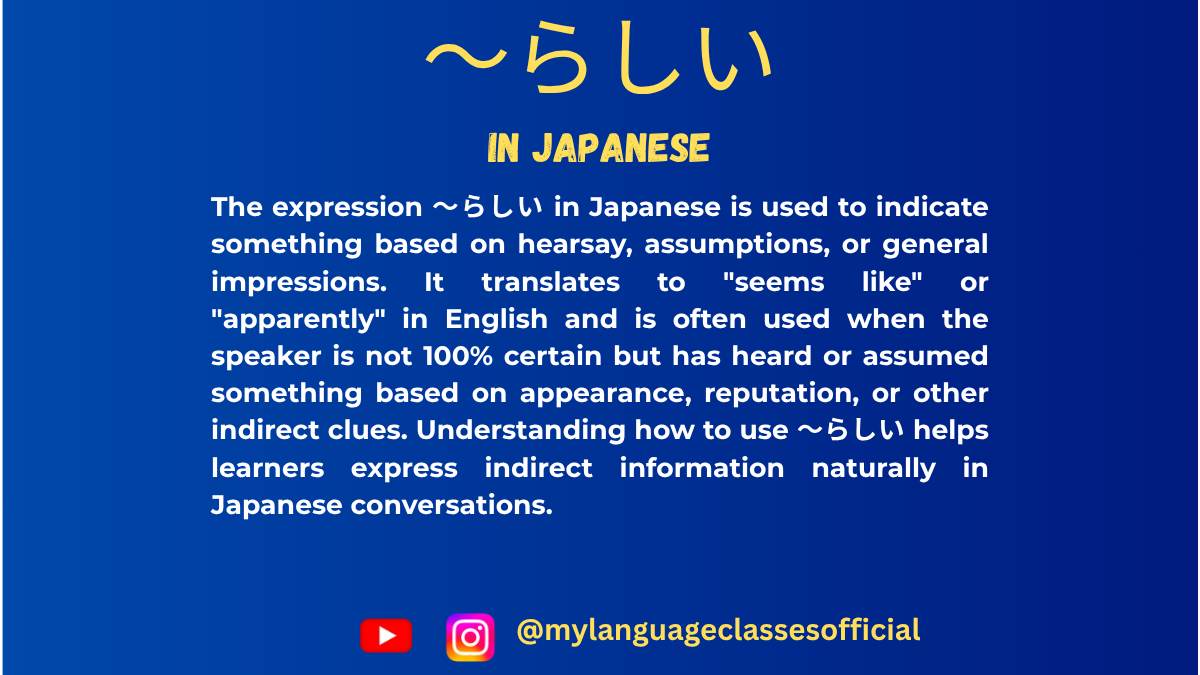
Understanding 〜らしい in Japanese | My Language Classes
Understanding 〜らしい in Japanese
When learning Japanese, one of the essential expressions to understand is 〜らしい. This suffix plays a vital role in expressing assumptions, hearsay, characteristics, and appropriateness. In this blog post, we will explore all possible usages of 〜らしい, providing clear explanations and examples.
1. Expressing Hearsay or Second-hand Information
One of the most common uses of 〜らしい is to indicate information that the speaker has heard from someone else but has not personally verified.
Structure:
Verb (Plain Form) + らしい
い-adjective (Plain Form) + らしい
な-adjective + らしい
Noun + らしいExamples:
- そのレストランは美味しいらしいよ。
(I heard that restaurant is delicious.) - たろうは今日休むらしい。
(I heard that Tarou is taking the day off today.) - この映画はめちゃくちゃ面白いらしい。
(I heard that this movie is really interesting.)
Usage Note:
Compared to そうだ, which is also used for hearsay, らしい implies that the information is based on indirect sources rather than direct observation.
2. Expressing Assumptions or Inferences
Another way to use 〜らしい is when making an assumption based on evidence.
Examples:
- たくさんの人が黒い服を着ている。 お蔵式があったらしい。
(Many people are wearing black clothes. It looks like there was a funeral.) - あの子はプロ野球選手の子どもらしい。
(That child seems to be the son of a professional baseball player.)
Usage Note:
This is different from ようだ, which is used for assumptions based on visual evidence, whereas らしい is based on reasoning or known facts.
3. Expressing Typical Characteristics
〜らしい can also be used to describe something that has the typical characteristics of a person, thing, or behavior.
Examples:
- このラーメンは日本らしい味だね。
(This ramen has a very “Japanese” flavor.) - かれは仕事に小さいことまで注意を払う。真面目らしい人だ。
(He pays attention to small details in his work. He is a serious person.) - 她はいつも元気で、すごく子どもらしい。
(She is always energetic, very much like a child.)
Usage Note:
This usage expresses the “essence” of something or someone. It is similar to みたい but is more about inherent qualities rather than just resemblance.
4. Expressing Suitability or Appropriateness
In some cases, 〜らしい can be used to indicate something that fits a certain expectation or role.
Examples:
- 日本らしいけしきゃんの誕生日プレゼントを買いたい。
(I want to buy a birthday present that is “Japanese-like”.) - 少年らしい仕事を求めている。
(Looking for work suitable for young people.)
Usage Note:
This is closely related to the “typical characteristics” meaning but emphasizes suitability rather than mere resemblance.
Situations Where 〜らしい is Used
Below is a list of common situations where 〜らしい is applicable:
- Hearsay – When conveying information heard from others.
- Inference – When making an assumption based on indirect evidence.
- Typical Characteristics – When describing something as having the essence of a person, thing, or behavior.
- Suitability – When expressing something as being appropriate for a certain role or image.
- Rumors – When talking about unverified rumors or gossip.
Final Thoughts
Mastering 〜らしい is essential for expressing assumptions, typicality, and hearsay in Japanese. While it might seem tricky at first, practicing with real-life examples and distinguishing it from similar expressions like そうだ and ようだ will help you use it naturally.
By understanding these nuances, you’ll be able to sound more fluent and natural in your Japanese conversations. Keep practicing, and don’t hesitate to use 〜らしい in different situations!
If you enjoyed this lesson, be sure to check out more posts like this on my blog at My Language Classes. Don’t forget to subscribe my YouTube channel and follow me on Instagram for the latest language learning tips and lessons. Leave a comment below to share your thoughts, or ask any questions you have about nouns.
Happy learning! 😊
- そのレストランは美味しいらしいよ。
-

Adverbs of Place in Spanish: A Complete Guide
Adverbs of place (adverbios de lugar) are essential in Spanish to indicate where an action takes place. They help provide spatial context and are frequently used in daily conversations. In this blog, we will explore the most common adverbs of place, their meanings, and how to use them correctly in sentences.
Understanding Adverbs of Place
Adverbs of place describe the location of an action or object. They answer the questions: Where? (¿Dónde?) and To where? (¿Adónde?)
These adverbs do not change in gender or number, as adjectives do, but their placement and meaning depend on the sentence context.
Common Adverbs of Place and Their Meanings
Spanish Adverb Meaning Aquí Here Allí There (not too far) Allá Over there (far away) Cerca Near Lejos Far Encima On top Debajo Below, under Enfrente In front Detrás Behind Dentro Inside Fuera Outside Al lado Next to, beside Entre Between Alrededor Around
Common Expressions with Adverbs of Place
Here are some daily expressions using adverbs of place with their meanings and example sentences:
1. Aquí (Here)
- Estoy aquí. (I am here.)
- Pon el libro aquí. (Put the book here.)
- Aquí se come bien. (Here, one eats well.)
2. Allí / Allá (There / Over there)
- El coche está allí. (The car is there.)
- Allí vive mi abuela. (My grandmother lives there.)
- Vamos allá para ver la fiesta. (Let’s go over there to see the party.)
3. Cerca / Lejos (Near / Far)
- El supermercado está cerca. (The supermarket is near.)
- El aeropuerto está lejos de aquí. (The airport is far from here.)
- Mi casa está cerca del parque. (My house is near the park.)
4. Encima / Debajo (On top / Under)
- El libro está encima de la mesa. (The book is on top of the table.)
- El perro está debajo de la silla. (The dog is under the chair.)
- Las llaves están encima del escritorio. (The keys are on top of the desk.)
5. Enfrente / Detrás (In front / Behind)
- El cine está enfrente del restaurante. (The cinema is in front of the restaurant.)
- Juan está detrás de la puerta. (Juan is behind the door.)
6. Dentro / Fuera (Inside / Outside)
- Los niños están dentro de la casa. (The children are inside the house.)
- Voy a esperar fuera. (I will wait outside.)
How to Use Adverbs of Place Correctly?
1. Articles and Agreement
- Unlike adjectives, adverbs of place do not agree in gender or number.
- However, they often require a definite article (el, la, los, las) when specifying the location:
- Encima de la mesa (On top of the table)
- Debajo del coche (Under the car)
2. Adverbs with Prepositions
- Some adverbs need prepositions like de to clarify their meaning:
- Encima de, debajo de, detrás de, delante de
- El gato está debajo de la cama. (The cat is under the bed.)
3. Position in a Sentence
- Adverbs of place typically come after the verb or at the end of the sentence:
- El niño juega afuera. (The boy plays outside.)
- Nos vemos allí. (See you there.)
- In questions, adverbs of place often come at the beginning:
- ¿Dónde está tu mochila? (Where is your backpack?)
Adverbs of Place in Different Contexts
1. Motion vs. Static Position
- When describing movement towards a place, use hacia or para:
- Voy hacia allá. (I am going over there.)
- Camina para dentro. (Walk inside.)
- When indicating a fixed position, use adverbs alone:
- Estoy aquí. (I am here.)
2. Expressing Approximate Location
- Por aquí / Por allí (Around here / around there):
- Debe estar por aquí. (It must be around here.)
Conclusion
Adverbs of place are fundamental for effective communication in Spanish. By mastering their meanings, correct usage, and placement in sentences, you can confidently express spatial relationships in everyday conversations. Practice using them with different verbs and prepositions to sound more fluent and natural in Spanish!
Do you have any questions or need more examples? Let me know in the comments below!
If you enjoyed this lesson, be sure to check out more posts like this on my blog at My Language Classes. Don’t forget to subscribe my YouTube channel and follow me on Instagram for the latest language learning tips and lessons. Leave a comment below to share your thoughts, or ask any questions you have.
Happy learning! 😊


